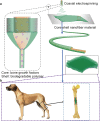Nanomaterials and bone regeneration
- PMID: 26558141
- PMCID: PMC4639780
- DOI: 10.1038/boneres.2015.29
Nanomaterials and bone regeneration
Abstract
The worldwide incidence of bone disorders and conditions has been increasing. Bone is a nanomaterials composed of organic (mainly collagen) and inorganic (mainly nano-hydroxyapatite) components, with a hierarchical structure ranging from nanoscale to macroscale. In consideration of the serious limitation in traditional therapies, nanomaterials provide some new strategy in bone regeneration. Nanostructured scaffolds provide a closer structural support approximation to native bone architecture for the cells and regulate cell proliferation, differentiation, and migration, which results in the formation of functional tissues. In this article, we focused on reviewing the classification and design of nanostructured materials and nanocarrier materials for bone regeneration, their cell interaction properties, and their application in bone tissue engineering and regeneration. Furthermore, some new challenges about the future research on the application of nanomaterials for bone regeneration are described in the conclusion and perspectives part.
Figures



References
-
- Giannoudis PV, Dinopoulos H, Tsiridis E. Bone substitutes: an update. Injury 2005; 36: S20–S27. - PubMed
-
- Li X, Wang L, Fan Y, Feng Q, Cui FZ, Watari F. Nanostructured scaffolds for bone tissue engineering. J Biomed Mater Res A 2013; 101: 2424–2435. - PubMed
-
- Stevens MM. Biomaterials for bone tissue engineering. Mater Today 2008; 11: 18–25.
-
- Stevens MM, George JH. Exploring and engineering the cell surface interface. Science 2005; 310: 1135–1138. - PubMed
-
- McMahon RE, Wang L, Skoracki R, Mathur AB. Development of nanomaterials for bone repair and regeneration. J Biomed Mater Res B Appl Biomater 2013; 101: 387–397. - PubMed
Publication types
LinkOut - more resources
Full Text Sources
Other Literature Sources

